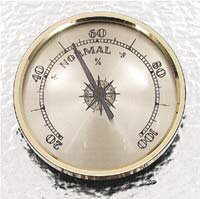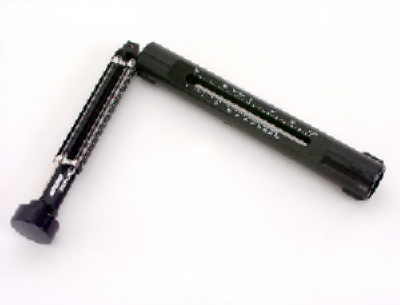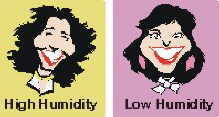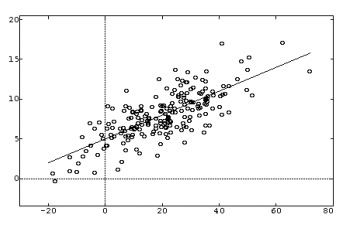- Air Homepage
- Weather Equipment
- Hygrometer Makes
A hygrometer makes humidity measurements - How?
Search for more about weather instruments.
People have created many
hygrometer makes and styles. Here's some of what I've seen and how they work.
In addition to adding class to your home or office, they're useful too. Humidity and temperature are sometimes displayed. A sensor like this is also needed for humidifiers and moisture controls.
Sometimes electronic hygrometers and digital hygrometers combine a temperature and humidity display. The executive desktop models have a hygrometer, thermometer, and digital clock.
Musical instruments, guitars, pianos, etc., and health environments like incubators are other places to measure dampness.
Taking relative humidity measurements
In meteorology, humidity is one of the most complicated quantities. We specify humidity in many ways because there are many ways of measuring it, and it depends on a lot of other things, like pressure, temperature, etc. Thermodynamics.
How do common hygrometer makes measure humidity?
Calculated by comparing the temperatures of two thermometers, one wet and one dry. Unless it's really humid, the wet one's cooler.
In the pictures above, a sling psychrometer holds the two thermometers and gives you a way to whip them around to get a better reading. By using this principle, you can make a homemade hygrometer, Assman psychrometer, or sling psychrometer. Many science fair topics can be derived from these ideas.
An indicator of humidity
Technically, a dew point sensor uses a salt-coated probe that absorbs moisture and conducts electricity better when there's more moisture.
There are also scientific hygrometers that use hair to measure humidity because it has natural moisture-absorbent properties that make it sensitive to humidity changes.
Calibration is also required. These kinds of hygrometers are used by temperature and humidity recorders.
Get to know a few new words
Definition Humidity: How many ways can you say Humidity?
Absolute Humidity - Concentration of Water in grams per cubic metre.
Mixing Ratio -
Water vapor (g) per kilogram of dry air.
Relative Humidity - This is the one we're most familiar with, since the usual home hygrometer talks about RH. This is the maximum mixing ratio at this temperature as a percent of saturation.
Basically, the percent is the ratio between the actual amount of water vapor in air and the amount that would be there if the air was saturated...
Saturation is often thought to be the maximum amount of water vapor the air can hold, but it's not. For our weather reports, we use a hygrometer to measure RH. You just look at a relative humidity chart.
Specific Humidity -
The concentration of water in parts per thousand.
Dew Point - Cold air has a higher relative humidity, even without adding any moisture. As it gets colder, RH starts to migrate towards 100% and dew starts to form. It's called the dew point.
We use frost point if it's cold enough. Same idea but colder. At the dew point, water vapor condenses into liquid. Frost forms when the temperature drops below the dew point. This quantity is recorded directly by environmental data loggers and other professional devices.
Wet Bulb Temperature - It would evaporate until the relative humidity of the air reached 100% if you covered the floor of a sealed room with enough water. However, the air temperature would drop until it reaches the wet bulb temperature.
This is measured directly by a hygrometer. Wet bulb means how cold it feels when you're wet, so it's measured by a wet thermometer.
Virtual Temperature - Since water vapor is lighter than air, moist air is also lighter. Air that's warm is lighter than air that's cold.
You'd have to heat dry air to the virtual temperature without changing the pressure, to make it as light as our moist air.
Humidex - An equivalent feels like the subjective temperature Canadians use to describe how uncomfortable it is on hot muggy days. Heat isn't their thing.
Vapor Pressure -
Water vapor pressure if all the air were removed and the vapor was left alone without collapsing the container. It's also called partial pressure of water vapour.
Other ones include lifting condensation level and ones with potential in the title. Their relationships require fancy math devices like the Clausius Clapeyron equation (which helps us understand how pressure changes with temperature, how temperature and pressure affect water turning into vapour, and how much pressure we get at certain temperatures), a psychrometric calculator, or graphs like Skew-T log P or tephigrams.
Most commercial hygrometer makes just give you the relative humidity, but psychrometric software can convert between them.
#16
Search this site for more information now.
Also, go to the Stuff In The
Air home page to see what other useful knowledge you can find.
Go back from Hygrometer Makes to the
Weather Equipment web page now.
What types of hygrometers are available? Do you need measurements of humidity and dewpoint?
Do you know what a hygrometer is? It is possible to determine the amount of moisture in the air using a hygrometer.
Do you have concerns about air pollution in your area??
Perhaps modelling air pollution will provide the answers to your question.
That is what I do on a full-time basis. Find out if it is necessary for your project.
Have your Say...
on the StuffintheAir facebook page
Other topics listed in these guides:
The Stuff-in-the-Air Site Map
And,
Thank you to my research and writing assistants, ChatGPT and WordTune, as well as Wombo and others for the images.
GPT-4, OpenAI's large-scale language generation model (and others provided by Google and Meta), helped generate this text. As soon as draft language is generated, the author reviews, edits, and revises it to their own liking and is responsible for the content.






New! Comments
Do you like what you see here? Please let us know in the box below.